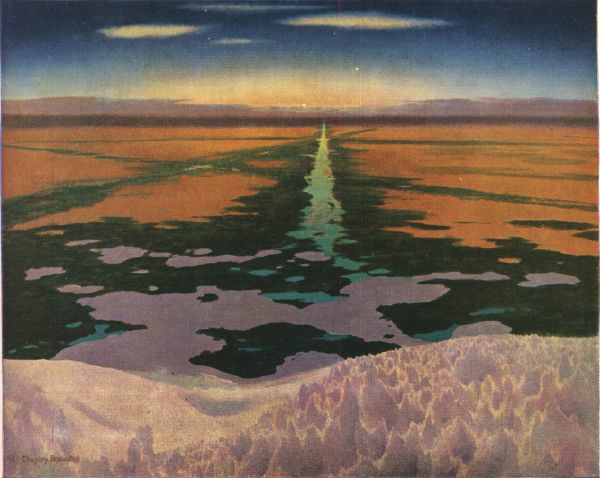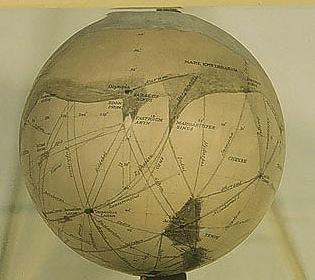
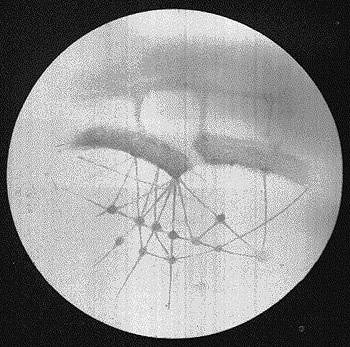
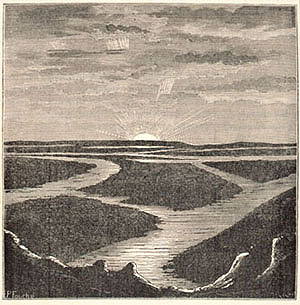
 |
 |
 |
How about another optical illusion that probably doesn't exist? Drawing the details of the planetary surface of Mars, even during the once-every-two-years "oppositions" in which Mars is relatively close to the earth, has defeated most optical astronomers of the past two centuries. The earth's atmosphere at best is wavery and unstable in the telescope's line of sight. Surface "details" tend to pop out during all-too-brief instants of steady "seeing." Astronomers could see that the surface of Mars was mainly reddish, with scattered large grey regions. The most distinctively dark of these grey regions, the roughly triangular Syrtis Major, was observed as long ago as 1659. In the late 1870s an astronomer reported that he could sometimes see smudgy connections between the markings. By 1900, an eccentric millionaire turned astronomer, Percival Lowell, was making sketches, maps and even globes that showed the Martian surface criss-crossed with very fine linear features, often running as two parallel lines. Where two or more lines crossed or converged, there was a roughly circular blob. Astronomy books these days, and indeed since the 1940s, have dismissed Lowell's drawings as optical illusions, claiming that vaguely described "experiments" with British schoolboys in the early 20th Century showed that when asked to make drawings of sketches with many randomly-scattered fine details, the boys often drew lines. Actually, however, I am not aware of any such illusion! [A more recent, equally bogus explanation is that Lowell was drawing the inside of his own eye, the "canals" being blood vessels in the retina.] The whole "optical illusion" scenario seems to be a way to make Lowell appear less crazy than he actually was. His drawings were motivated, not by what he glimpsed in his telescope, but by what he wanted to see. No imaginable optical illusion could have genuinely given Lowell the impression he drew--- spiderweb-fine lines crisscrossing the Martian Deserts, a gigantic engineering project by which water-starved Martian civilization distributed the relatively tiny volume of water to the few remaining Martian urban and agricultural centers. [Canal commentators generally don't seem to notice that the standard broad Martian albedo features as drawn by Lowell look nothing like what other observers of the period consistently drew, much less what modern photos reveal. That is, almost all features shown, not just the canals, tend to be largely works of imagination. For a mid-20th century version of the standard albedo features, click here.]
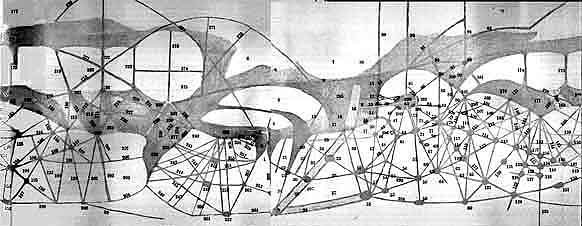
Like any classic pseudoscientist, Lowell jumped from the broad smudges seen by one or two astronomers in the 1870s to a full-blown scenario of Martian irrigation. No optical illusion led to his sketches. His sketches were fantasies in support of his scenario. Other astronomers of the period who were not Lowell employees did not see "canals," although they sometimes did draw the grey smudges narrowing into broad linear features. And many of these broadly linear features are real, as the space probes of the 1960s and later revealed. But nobody saw Lowell's canals, before, during or after the time he reported them. The excellent photos available during the last 30 years have made possible the drawing of wonderful, beautiful, and amazingly faithful maps of the Martian "albedo" features, and the even-more-amazing surface "relief" features, including towering volcanic cones, dry riverbeds, and immense canyons and chasms... even apparently the "dead sea bottoms" so beloved of Edgar Rice Burroughs in his early 20th Century series of novels set on Mars, and clearly inspired partially by Lowell and partially by Madame Blavatski's Atlantis. Click here, and here, for some awe-inspiring Mars maps.

Typical of the conventional and almost certainly wrong discussions of Martian canals are the two examples found here.
